
Enforcing border controls can create long queues for travellers, David Crawford looks at potential solutions.
Long delays at border crossings in both North America and Europe have sparked the development of new queue visualisation and management technologies that are cutting hours, even days, off international passenger and freight journeys. At the westernmost end of the 2,019km (1,250 mile) Mexico–US frontier, two parallel crossings between Tijuana, in the former country, and the border city of San Diego, in California (the second opening in 2015) are now benefitting from innovative thinking by a frustrated regular user.
The earlier implementation has already transformed the world's busiest international port of entry into the San Ysidro district of San Diego. This can experience up to 300,000 northward movements every day, with waiting times as long as three hours, or longer, at peak times.
The reason is that the border is heavily physically guarded and policed at the US end to deter illegal entry by undocumented migrants and drug traffickers.
Southbound flows have long been less busy; but, since 2015, there have been daily rush hour jams, lasting an hour or more, despite Mexico's lighter controls at a modern, efficient entry port. The change reflects increasing numbers of people commuting between home and work in both directions.
Northbound there are several distinct lanes for entering the US, some reserved for travellers carrying electronic documentation; southbound there is a single queue. The US government estimates that the delays have caused annual losses of US$6bn in productivity, commerce and tourism.
The breakthrough came with the launch of the <%$Linker:
The founder, San Diego-based Greg Yova, drew on his engineering degree to develop the system in response to the frustrations he was experiencing as founder of the Project Mexico charity, which builds homes (and recently an orphanage) for the country's poor.
Return journeys into the US for project officials, volunteer workers (15,000 over 20 years) and trucks delivering construction and other materials (often donated) were fraught with delays.
Looking for an answer, he ruled out conventional traffic sensors on the grounds that the typical derived displays, using colours on road links on a digital map, did not deliver the timely and detailed picture of queues that he wanted, especially in congestion at slow speeds.
Again, available traffic information websites tended to feature regularly-updated camera stills. “When traffic gets busy, they show a lot of cars, but you have no idea how fast these are moving”, he told ITS International. “We looked at live streaming but that has drawbacks – it’s expensive, bandwidth-hungry, doesn’t play on all mobile devices, and has security implications.
“We then realised that traffic video doesn’t have to be to-the-second live. So we update every few minutes, which means that the images are on average half that number of minutes old - fine for drivers to make journey decisions.”
The resulting solution is now installed on both sides of the border, at the original crossing and the parallel one from Tijuana to the Otay Mesa district of San Diego – enabling drivers to compare the situation on each. The system uses output from over 40 cameras, with cellular modem connections where the internet is not available.
It involves a 10-second video loop, refreshed at set intervals with the content validated through time stamps and watermarks. “It works out roughly 80% cheaper than full live video streaming,” said Yova.
The system is optimised for cameras supplied by Axis Communications; but, he continued, “the software will capture from virtually any source, even legacy analogue ones using an inexpensive transcoder”. The website currently attracts over two million page views per month and the service is funded by a 'VIP' fee. A newly-launched app enables drivers to input their specific needs – for example, identifying when the waiting time to enter the US or Mexico is 20 minutes or less – and receive a confirmatory email or text message to a mobile device. The underlying AccuWait proprietary technology uses advanced video analytics.
Border crossing waiting times have been reduced by 20%. The US Customs and Border Patrol (CBP) estimates that it is saving at least US$30,000 per month by scheduling their staff more intelligently. Previously, border guards were unable to see to the end of the queue to assess its length.
Other recent deployments are in domestic queue management systems for US states and freeways, while Qvision plans to expand its border offer to others of the ten busiest crossings between the US, Canada and Mexico.
Outside North America, a recent demonstration of Qvision’s 'animated jamcams' for Transport for London at the Blackwall Tunnel pinch point in east London, showed, in an accompanying survey, that 96% of respondents agreed that moving images were more useful. the key outcome was confirmation that people changed their journey time, route or mode to avoid the jams.
TfL has now implemented a simplified version of the system and, under the agency's open data policy, app developers can access five-second looped videos from available cameras, allowing users to see how traffic is moving along particular roads. Yova claims that his technology “helps level the load on the road network without expensive roadside equipment or more building”.
Qvision is currently negotiating with other European cities and has just launched a project in India.
In a European initiative, Estonia-based GoSwift has won the International Transport Forum's 2015 Transport Achievement Award for its speeding up of freight queues on the border between the Baltic state and Russia. Delays could typically last for days, with no facilities available for drivers, leading to problems over rest periods, air pollution, waste and security.
The system, installed by the Estonian Ministry of the Interior, is now operating at three border crossings on a pay-by-use basis. It allows the truck driver or controller to pre-book a slot or join a virtual queue.
A truck travelling from Poland through the Baltic States to Russia on a fixed schedule can pre-book its crossing before leaving. The booking can be made up to a month in advance via the internet, by phone to a call centre, or at self-service points or cash desks in nearby waiting areas.
Alternatively, a truck with a short-notice delivery can join a virtual queue and arrive at the allocated time. Vehicles carrying perishable loads can apply to join a priority virtual queue. An algorithm developed by GoSwift allocates slots for the appropriate option. Trucks that arrive unaware of the system are directed to a waiting area to book or join a virtual queue.
Drivers can check their place online, or via a self-service terminal in a waiting area, and opt to change their slot in response to any rescheduling instructions from their base. Trucks in the waiting areas are called to the border by SMS and/or display screens when it is their turn.
Lengthy queuing had been an issue for over 10 years, with freight traffic as the main source as well as the impacts on the needs of local inhabitants and tourists. A key driver was the need to improve the situation without the need for major investment in the infrastructure at the border crossings.
With average queuing times now down to two hours, the Association of Estonian International Road Carriers has announced resulting annual savings for its members’ of €4 million (US$4.4 million).
In the reverse direction, the system was in pilot operation for 1.5 years at a single crossing point from Russia, until that country's government withdrew financing in early 2014. But, GoSwift sales director, Madis Sassiad, told ITS International: “We could restart within a week.”
Founded in 2011, the company now operates in two additional countries, Lithuania and Finland. In the latter, mandatory truck booking for the crossing from Vaalimaa into Russia came into force in a December 2014 trial and continues to operate.
GoSwift's future ambitions extend to Africa and the Middle East. It is currently working on overcoming border bottlenecks on long-distance corridors such as the New Silk Road project, first proposed in 2013 by Chinese president Xi Jinping, which is planned to run from the Pacific Ocean to the Baltic Sea.
- About the author: David Crawford has spent 20 years writing about and researching ITS and is a Contributing Editor to ITS International.














